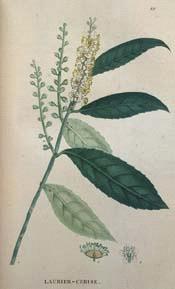

|
Cherry Laurel
(Prunus laurocerasus LINN.)
|
Laurel, Cherry
Botanical: Prunus Laurocerasus (LINN.)
Family: N.O. Rosaceae
---Synonyms---Laurocerasifolia. Cherry-Bay. Common Laurel. Laurier-armande. Laurier aux Crèmes. Laurier-cérise.
---Part Used---Fresh leaves.
---Habitat---A native of Asia Minor. Largely cultivated in Europe.
---Description---This small, evergreen tree, growing to 20 feet in height, has spreading, slender branches, smooth, shining, and pale green. The leaves are thick, alternate, on short, thick stalks, oblong-ovate, from 5 to 7 inches long, growing narrower at each end, and with a slightly serrate margin. The dark green upper surface is smooth and shining and the under one much paler, dull, and the midrib very prominent. There are glandular depressions and hairs near the base.
The five-petalled, small white flowers grow in erect, oblong racemes. The fruit resembles black cherries, but grows in clusters like grapes. The leaves are without odour except when bruised and added to water, when they have the ratafia or almond odour of prussic acid. The taste is bitter, aromatic, and astringent.
The shrubs were introduced into Europe about 1580, and shortly afterwards into England.
The leaves are used for flavouring, but should be used with great care, owing to the risk of poisoning.
Cherry-Laurel Water has been used in Paris fraudulently to imitate the cordial called Kirsch.
The most active essence is reserved for perfumery.
There is difference of opinion as to the best season for gathering the leaves. Drying destroys the active principle.
The bruised leaves, like those of peach or almond, when rubbed within any vessel will remove the odour left by oil of cloves, balsam of copaiba, etc., if the grease has first been cleaned away with alcohol.
---Constituents---The leaves yield a volatile oil in the proportion of 40.5 grains to 1 lb. of leaves. This resembles oil of bitter almonds, and in Europe is sometimes sold for it, as flavouring, but the glucoside decomposes more slowly than crystallized amygdalin, and is liable to hold hydrocyanic acid, when it becomes poisonous. This glucoside was called Laurocerasin, or Amorphous amygdalin, and now Prulaurasin.
With emulsin and water, prulaurasin is decomposed, and yields benzaldehyde, hydrocyanic acid, and dextrose.
- Cherry Laurel Water (Aqua Laurocerasi), according to the British Pharmacopceia, is prepared as follows:
- 'One pound of fresh leaves of cherrylaurel, 2 1/2 pints of water. Chop the leaves, crush them in a mortar, and macerate them in the water for 24 hours; then distil 1 pint of liquid; shake the product, filter through paper, and preserve it in a stoppered bottle.'
In America, oil of Bitter Almonds is often substituted, owing to the variability of the above.
---Medicinal Action and Uses---The water is a sedative narcotic, identical in its properties, to a diluted solution of hydrocyanic acid, but of uncertain strength.
---Dosage---Water, B.P., 1/2 to 2 drachms. Used for asthma, coughs, indigestion and dyspepsia, 1 drop of sulphuric acid added to a pint of Cherry Laurel Water will keep it unchanged for a year.
[Top]
Common Name Index
A MODERN HERBAL Home Page
Bear in mind "A Modern Herbal" was written with the conventional wisdom of the early 1900's. This should be taken into account as some of the information may now be considered inaccurate, or not in accordance with modern medicine.
© Copyright Protected 1995-2004 botanical.com

|

